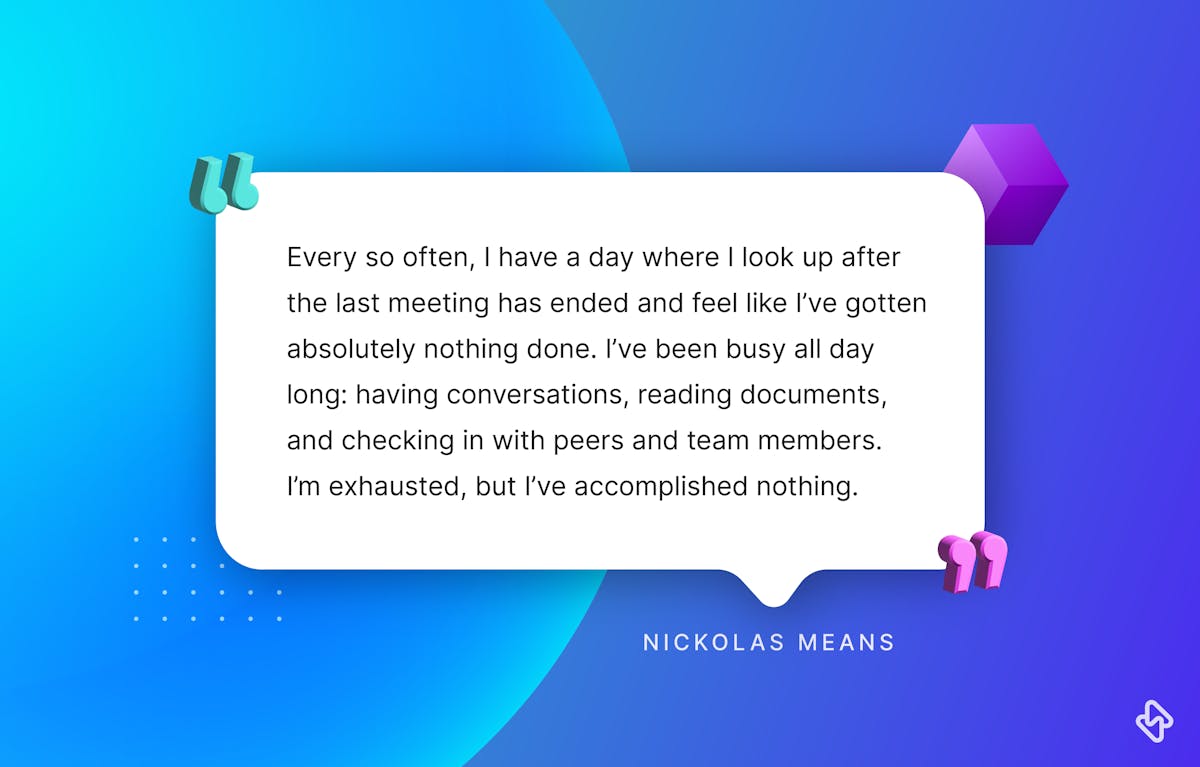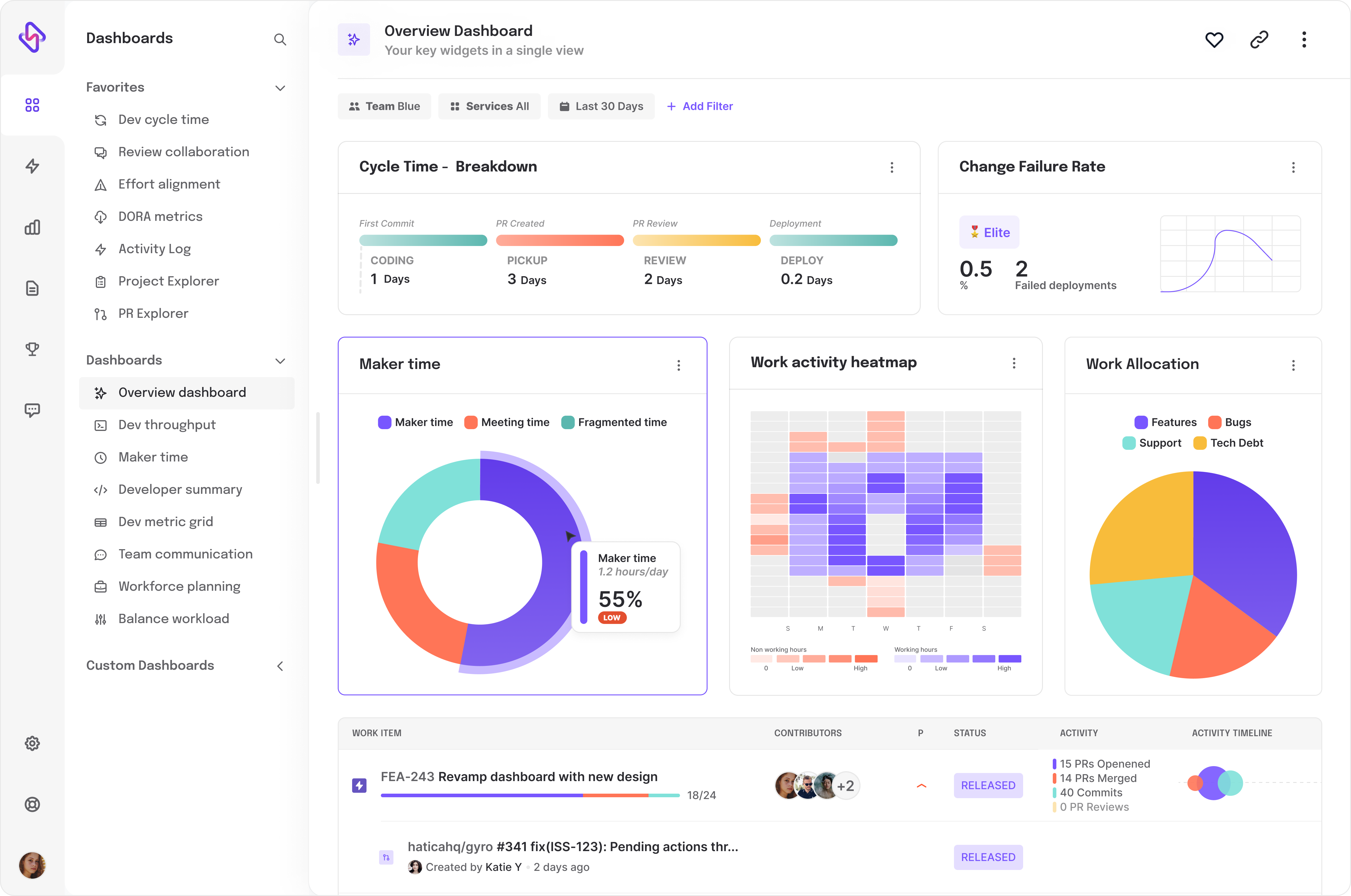Engineering managers need to be constantly updated with their dev's work items. The idea is to take stock of the present team status: what the engineers are doing, their blockers, and how to move forward. That's why standups were originally invented. But, most standups today are more or less about status updates and rarely end with some constructive feedback, or discussing blockers.
Even after hour-long calls, devs might not have clarity over how to resolve their blockers. Ever happened that you know your devs are frustrated because of work, but couldn't figure out why? Pining devs for constant updates might alienate them from managers- their best buddies/mentors/support system at work. Ongoingly, it can hurt the team's focus hours irrevocably, even hurting developer productivity. EMs now need to find a balance between taking status updates, and 'qualitatively' resolving dev barriers.
How to Overcome a Broken Communication Challenge?
Effective communication is vital for successful team collaboration. Engineering managers should focus on resolving communication issues and aligning software teams.
Automated standup tools for your communication stack (Slack, Teams, Emails) can help engineering leaders in knowing the daily work tasks, and progress made, and even identify blockers on the go. This balanced approach ensures managers stay informed while actively resolving development barriers.
3. Developer Burnout
When it comes to the developer ecosystem, everything is related and interconnected. Developer burnout has become a common workplace phenomenon, with over 82% of developers going through reversal burnout symptoms. An engineering manager is considered a pillar of support for their devs and is expected to help navigate the crisis with much empathy, and a plan of action to get them back in shape, and spirits.
However, managers cannot be of much help to devs if they don't know what causes this alienation in the first place. Figuring out the reasons for your dev's withdrawal, and lacking enthusiasm is a key priority challenge for leaders today. In the same survey above, 77% of developers have accepted that their managers are not aware of what's happening. The causes could be anything; from overwhelming adhoc requests to dysfunctional work conditions, incident alerts, and debugging outside work hours. Since EMs are already dealing with work visibility challenges, these signs often come too late to them. By then, either their high-performing devs quit, become disengaged, or face a powerful loss in their productivity.
Here are some approaches to overcome this specific challenge.
Solution to Overcome Developer Burnout Challenge
Addressing developer burnout requires empathy and proactive measures. Engineering managers should understand the causes of burnout, ranging from overwhelming ad-hoc requests to dysfunctional work conditions.
4. Unsustainable Workload
Workload distribution among members may sound like a direct task, but it’s complicated and hands down, one of the hardest for an engineering manager. In a SmartBrief survey, only 29% of engineering leaders were fairly confident of their workload distribution. The issue rapidly snowballs into frustrated devs if managers have low visibility into the engineering workloads (the big deal about visibility, eh?). Sometimes, the work allotment is done without accounting for geographical barriers, past trends of progress, and existing work share. Your next sprints are destined to go down if devs are not able to clear their previous backlogs owing to overburdening work.
Solution to Overcome Unsustainable Workload
Engineering managers need to figure out achievable (and practical) ways to distribute work, especially by keeping all members on the same page. One way is to use data-driven visibility for managing your dev's workplate: PR reviews, interview load, WIP tasks, and more. It is easier to plan productive work this way, and even create happy developers as an added outcome.
5. Poor Developer Experience
Devs are good at switching teams, based on their career progress, happiness, or overall satisfaction. However, for EMs, this transition is like a double-edged sword- core hours devoted by devs per project are decreasing, while the training, and recruiting time keeps increasing. And that's why protecting developer experience by managers becomes vital to the future of a company.
Good DX doesn't necessarily have to follow Steve Jobs' come-make-it-your-world approach, so much as it's about improving a developer's involvement, and satisfaction with the current workflow. If your current process has long code review periods, workload imbalance, security issues, frequent firefighting, flaky builds, high incident and interview workloads, and devs had to undergo frequent context switching and technical debt; then your life as an engineering manager might take a lot of toils.
Most of these listed aspects are overlooked because they’re either not easy to detect, or measured, termed complex, and even messy. What engineering managers need to understand is how ignoring these indicators can hurt your devs in the long run. A Great DX is your 'silver bullet' to keep your devs happy, mitigate burnout tendencies among members, and create lasting value out of your dev's work. 10x engineers are not a myth anymore; sustaining DX over time can help you build one.
Solution to Overcome Poor Developer Experience
Protecting developer experience is essential for retaining talent and fostering team cohesion. Engineering managers should focus on improving the workflow, reducing code review periods, addressing workload imbalances, and minimizing technical debt.
6. Manage Remote and Distributed Teams
With the rise of remote work and distributed teams, engineering managers face the challenge of effectively managing and coordinating team members who are geographically dispersed. They need to establish robust communication channels, leverage collaboration tools, and foster a sense of cohesion and engagement among team members.
Consider implementing the following approaches to tackle this specific challenge.
How to Manage Remote and Distributed Teams?
Engineering managers can implement the following solutions to manage remote and distributed teams effectively. They should establish robust communication channels, utilizing tools such as video conferencing, instant messaging, and project management platforms.
Regularly scheduled virtual meetings and check-ins foster a sense of connection and allow team members to collaborate and share updates. Encouraging clear and transparent communication, setting clear expectations, and promoting a strong team culture is vital for motivating remote teams.
7. Scale and Manage Growth
Engineering managers face the challenge of scaling their teams and processes as companies grow while maintaining productivity and quality. They must develop scalable systems, implement effective project management methodologies, and provide leadership in guiding their teams through growth phases while ensuring a seamless transition.
Consider implementing the following approaches to tackle this specific challenge.
How to Scale and Manage Growth?
Scaling teams while maintaining productivity and quality requires careful planning and execution. Engineering managers can address this challenge by developing scalable systems and processes.
8. Adapt to Regulatory Changes
Engineering managers must navigate the ever-changing regulations and compliance requirements landscape to ensure their teams operate within legal boundaries. They are crucial in ensuring their teams adhere to industry standards, privacy regulations, and data protection laws. Staying informed about regulatory changes is paramount, as it allows engineering managers to identify and address potential risks or gaps in compliance proactively.
Engineering managers should establish transparent processes and guidelines to tackle this challenge to ensure their teams understand and follow the necessary regulations. This may involve conducting regular audits and assessments to assess compliance levels and identify improvement areas. Collaborating with legal and compliance experts can provide valuable insights and guidance in navigating complex regulatory frameworks.
Here are some of the methods to overcome this specific challenge.
How to Adapt to Regulatory Changes?
Implementing necessary processes and safeguards is vital to avoid legal and reputational risks. Engineering managers should ensure that proper documentation, protocols, and training programs are in place to educate team members on compliance requirements. This includes fostering a data privacy and security culture where team members know their responsibilities and actively contribute to maintaining compliance.
Engineering managers demonstrate their commitment to ethical and responsible practices by proactively adapting to regulatory changes. They protect their teams and organizations from potential legal consequences while preserving their reputation as trustworthy and reliable entities.
9. Keep Up with Technological Advancements
Technology evolves rapidly, and engineering managers must proactively stay updated with the latest advancements to remain effective. They should invest time in continuous learning and professional development to expand their knowledge and skill sets. This can involve attending industry conferences, workshops, and webinars focusing on emerging technologies and industry trends. By actively engaging in these opportunities, engineering managers gain valuable insights, network with industry experts, and broaden their perspectives. They can then share their learnings with their teams, fostering a culture of continuous learning and innovation.
In addition to personal growth, engineering managers should encourage their teams to stay abreast of new technologies. This can be achieved through various means, such as organizing internal knowledge-sharing sessions, sponsoring relevant training programs, or providing access to online learning platforms. By empowering their teams to stay current with industry trends, engineering managers create an environment that embraces innovation and encourages the exploration of new tools and techniques. They can also foster cross-functional collaboration by facilitating interactions between different teams or departments, enabling knowledge exchange and the discovery of new approaches.
Here are some effective approaches to tackle this particular challenge,
How to Keep Up with Technological Advancements?
Engineering managers should prioritize continuous learning and development to keep pace with technological advancements. They can allocate time to research and explore emerging technologies and industry trends. Encouraging their team members to stay updated through training, workshops, and attending conferences fosters a culture of innovation and growth. Collaborating with other departments, participating in industry forums, and engaging with technology communities can also provide valuable insights into the latest advancements, enabling managers to make informed decisions and drive innovation within their teams.
10. Balance Technical and Managerial Responsibilities
Engineering managers often face balancing their technical expertise with their managerial responsibilities. They must stay updated with the latest technologies and industry trends while managing teams, overseeing projects, and making strategic decisions. Finding the right balance between hands-on technical work and managerial tasks is crucial for their success.
Here are some practical approaches to tackle this particular challenge.
Solutions to Balance Technical and Managerial Responsibilities?
Striking the right balance between technical expertise and managerial responsibilities is critical. Engineering managers can allocate time for both by delegating tasks, empowering team members, and leveraging the skills and expertise of their team. Regularly assessing workload and prioritizing tasks can ensure that technical and managerial responsibilities are effectively managed. Investing in personal development, attending relevant training programs, and seeking mentorship or coaching can also help enhance organizational skills and technical knowledge simultaneously.
Getting to the Bottom of an Engineering Manager's Challenges
The developer ecosystem is not a tough nut to crack; most engineering managers start as devs and understand the pain points of inefficient processes. However, without the right visibility into a dev's whereabouts, managers will have a hard time building a productive, burnout-free, cohesive team. Team synergy, happy developers, and a self-sufficient team that works without blockers (or rectifies one easily), are hallmarks of an engineering manager’s success at work.
Using an engineering management platform can help managers to be on top of dev workflows, and even take the right set of actions to mitigate the challenges discussed above.
As teams become more complex, and distributed, sync meetings shouldn’t have to stay as the go-to place for collaboration, rather it's time for managers to build a data-driven culture that fosters bonding and ease of work equally.
With over 130+ engineering metrics, Hatica is an engineering management platform that equips engineering managers with visibility into their team’s workload, contributions, and processes to help them manage work effectively without burnout. Request a demo and explore Hatica further, and last but not least, don't forget to drive your decisions with data, a pinch of compassion, and team satisfaction.







